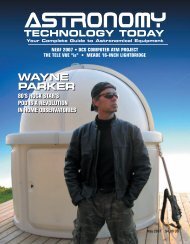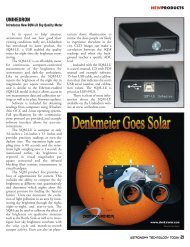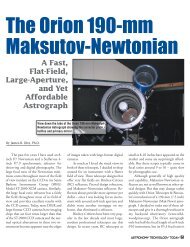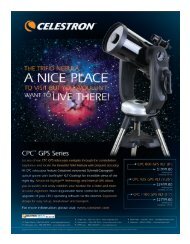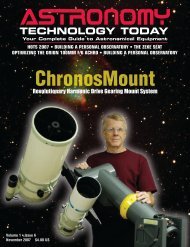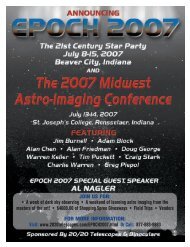iOPTRON - Astronomy Technology Today
iOPTRON - Astronomy Technology Today
iOPTRON - Astronomy Technology Today
You also want an ePaper? Increase the reach of your titles
YUMPU automatically turns print PDFs into web optimized ePapers that Google loves.
M-UNO: A PIER-LESS MOUNT<br />
Image 8 - Arp 244 in Corvus (L only).<br />
ware and Cartes du Ciel for object selection<br />
and go-to operation.<br />
Right from the start, I was greatly impressed<br />
with the smoothness of the mount’s<br />
motions and its nimble responses to commands.<br />
It handled like a Lamborghini. The<br />
go-to functioned perfectly, placing the objects<br />
right where I wanted them. Adjusting<br />
the object’s position in order to locate a<br />
suitable guide star was precise and effortless.<br />
Luciano explained that the auto-guiding<br />
settings should be set at 0.05 to 0.02<br />
seconds (a low setting in my experience) in<br />
order to avoid overcorrection and oscillation.<br />
I began the imaging run shortly after 8<br />
p.m., after the end of astronomical twilight.<br />
The first target was the Horsehead<br />
Nebula in Orion, an object I had not imaged<br />
before. Orion was already nearing the<br />
meridian, but that was no problem for the<br />
M-Uno. I took a 60-second image, a 5-<br />
minute, and three 20-minute images. During<br />
that run, the object transited the<br />
meridian without any need to adjust the<br />
mount or the guiding settings. The tracking<br />
was optically flawless. Using Maxim’s<br />
error graph log recorder, over a ten minute<br />
period (the program inexplicably quit<br />
recording error correction after ten minutes),<br />
the largest correction was 0.46 pixels,<br />
and that happened only once. Typical<br />
corrections were in the hundreths and low<br />
tenths of pixels in average seeing (for<br />
WSP). Not having to interrupt the imag-<br />
Introducing the 1600GTO German Equatorial Mount<br />
We proudly introduce the new 1600GTO German Equatorial Mount, which features optional<br />
Absolute Encoders available for both R.A. and Dec. - the pinnacle of precision. The Absolute<br />
Encoders provide completely error-free tracking, software readable absolute position, homing<br />
and customizable limit functions.<br />
“Thirty plus years of mount building expertise has been employed to engineer and build<br />
our new 1600GTO mount into the most robust, high precision mount in its class. We have<br />
enhanced its design and utility by incorporating additional optional features like absolute<br />
encoders, sophisticated control systems and a new precision polar scope to exceed the<br />
needs of even the most demanding astro-imager or visual enthusiast.” Roland Christen,<br />
President & Owner of Astro-Physics, Inc.<br />
With a capacity of 220 lbs (100 kg), the 1600GTO is ideal for refractors up to 250mm, or 18-20”<br />
Cassegrains, Ritchey-Chretiens and CDKs. It has the ability to image past the meridian for up<br />
to six hours. The 1600GTO is transportable with through-the-mount cabling and keypad and/or<br />
computer control. Every part is hand finished and inspected. All assembly is done by hand to<br />
guarantee the quality and reliability we at Astro-Physics demand and that our customers have<br />
come to expect.<br />
48 <strong>Astronomy</strong> TECHNOLOGY TODAY



